Sixties
City presents
a wide-ranging series of
articles on all aspects of the Sixties, penned by the creator of the iconic
60s music paper Mersey
Beat
|
Sixties
City presents
a wide-ranging series of
articles on all aspects of the Sixties, penned by the creator of the iconic
60s music paper Mersey
Beat
|
||||||
|
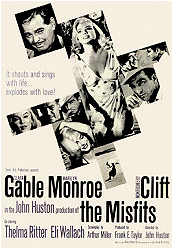 |
As
it turned out, the film was not a critical success and most of the publicity
centred on the immense personal problems of all concerned. With Marilyn’s
lateness, dependence on drugs, the depression of her doomed affair with
Yves Montand and the break-up of her marriage with Arthur Miller. With Miller’s humiliating treatment by Marilyn during the filming; Monty Clift’s reliance on drink and drugs and, due to the fact that Clark Gable died shortly after the film’s completion, the stigma was that ‘The Misfits’ was directly responsible for his death due to the immense boredom and tension waiting for Marilyn to turn up and the physical strain the 59 year old actor experienced in the action sequences. John Huston was to write in his autobiography: “One of the myths attached to ‘The Misfits’ was that Clark Gable died of a heart attack because of over-exertion on this film. This is utter nonsense. Toward the end of the picture there was a contest between Clark and the stallion the cowboys had captured. It looked like rough work, and it was, but it was the stunt men who were thrown around, not Clark.” The film had its origins in a short story Miller had written for Esquire magazine. When Miller had been living in Nevada to establish residence in order to divorce his first wife, he met three cowboys who made their living capturing wild horses which they sold for dog meat. A photographer friend of Miller’s, Sam Shaw, had read the story, ‘The Last Frontier of the Quixotic Cowboy’ when it had first been published and suggested that Miller turn it into a film script. Miller decided to write it as a special vehicle for his second wife, Marilyn Monroe on the suggestion of Shaw, who commented, “It would make a great movie and that’s a woman’s part she could kick into the stands.” Miller was to comment that ‘The Misfits’ was: “A story of three men who cannot locate a home on the earth for themselves and, for something to do, capture wild horses to be butchered for canned dog food; and a woman as homeless as they, but whose sense of life’s sacredness suggests a meaning for existence." “It was a story about the indifference I had been feeling not only in Nevada but in the world now. We were being stunned by our powerlessness to control our lives, and Nevada was simply the perfection of our common loss.” |
| Frank
Taylor, who was Miller’s former book editor, was talked into giving up his
post at Dell Books to act as producer. In 1959 Taylor called Huston at home
in Ireland and he agreed to direct. They also talked Clark Gable into accepting
the role of Gay Langland, although he was initially puzzled by the script
and said, “It’s supposed to be a Western, but it’s not, is it?” “It’s a sort of Eastern Western,” said Miller and began to explain the philosophical aspects of it. Gable re-read the script that night and agreed to do the film the next day. He did, however, strike a very tough bargain, which made him the highest-paid actor in the world. He was guaranteed three-quarters-of-a-million dollars, 10% of the movie’s gross, 48,000 dollars a week overtime and complete control of the script. He’d recently completed ‘It Started In Naples’ and had intended to make only one further film, ‘Diamondhead’, before retiring. During the course of filming he discussed making ‘The Man Who Would Be King’ with Huston and another film with Marilyn. Production was scheduled to begin on 3rd March 1960 but an actors' strike had delayed production of ‘Let’s Make Love’ by five weeks and by the time ‘The Misfits’ began location filming the summer temperature in Reno, Nevada, was 110 degrees which was a great strain on both cast and crew. Neither Gable nor Monty Clift were in a fit state to pass the insurance physical, so Clark had to crash diet which brought his weight down to 195lbs and he stayed in bed for a whole week before the examination. Clift had to cut down on his booze and pills. The sun was at its hottest on 16th July when filming began and Huston began to experience problems because of Marilyn’s lateness. He’d said, “I knew Marilyn’s reputation for being late on the set so before we started shooting I had the daily call changed from 9am to 10am because this would make things easier for her. It didn’t.” Gable also had a clause in his contract that he finished work at 5pm each day. He was on the set each morning at 9am, knew his lines and was ready to leave at 5pm. Sometimes Marilyn wouldn’t show until 4pm. A decision had also been taken to shoot the film in a sequential method, like that of a play, rather than shooting disconnected scenes as was usual in filming. |
 |
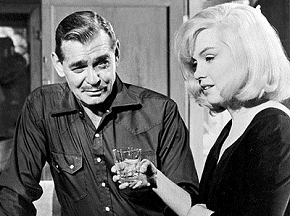 |
Lew Smith, Gable’s stand-in, said: “Maybe Marilyn idolized Gable like a
father, but she was in there pitching for more. She wanted him, if you know
what I mean, and he was a big flirt and a tease, he loved to pat her plump
fanny, knowing she never wore anything underneath. Or he’d pinch her and
whisper something in her ear.” There is a scene in the film where Marilyn, as Roslyn, is asleep in bed, naked under a sheet. Gable, as Gay, comes into the room and bends over to give her a good morning kiss, she rises slightly to meet him. During Take Seven she let the sheet slip to expose her breast to one of the two cameras. Both she and Frank Taylor wanted the take to be used and Marilyn commented, “I love to do the things the censors won’t pass. After all, what are we all here for, just to stand around and let it pass us by?” Huston, however, wouldn’t use the take in the film, saying: “I’ve always known that girls have breasts.” However, the shot was used in the European cut of the film. Marilyn told her maid, Lena Pepitone, “I was so thrilled when his lips touched mine, I wanted to do it over and over. Then the sheets dropped and he put his hand on my breast. It was an accident, but I got goose bumps all over.Everything he did made me shiver – the kiss, the touch, his eyes. That night I didn’t need a sleeping pill, but I dreamed that we did it. God, I was in heaven. When I woke up, I knew I had to have him. Whenever he was near me, I wanted to grab him around the neck and hold him forever. I wanted him to kiss me, kiss me, kiss me. There were times I thought he’d give in – ask to meet later – but he never did. We did a lot of touching and kissing and feeling. I never tried harder in my life to seduce any man. He was my dream come true. His wife caught us smooching once. I don’t think she likes me, but I don’t really care. She’s got him. I don’t.” |
| The
third screen legend to appear in the film, Montgomery Clift, had once seemed
to be blessed by the Gods – amazingly handsome, with an original talent
and the potential to become a superstar. An accident disfigured his looks,
his homosexuality led him to drink and drugs and the film offers began to
dry up. Huston was pleased with his work on ‘The Misfits’ and said: “He
never missed an hour’s work, he had his entire part memorised before shooting
began and he was always on time despite the long delays in finishing the
picture.” Commenting on Marilyn, Huston said: “She was appreciated as an artist in Europe long before her acceptance in the United States. Jean-Paul Sartre considered Marilyn Monroe the finest actress alive. He wanted her to play the leading female role in ‘Freud.’” When Huston filmed ‘Freud’ with Monty Clift in the title role, he’d wanted Marilyn to co-star. He said: “Marilyn had been the first choice to do the part of Cecily in ‘Freud’. Her own analyst, however, advised against it. Not out of concern for Marilyn, he didn’t believe a picture about Freud should be made at all because Freud’s daughter opposed the project. Later, after he had seen the picture, he told me that he felt he had made a mistake in this. If he had known the type of picture it was to be, he would have recommended that Marilyn do it.” Just as Gable looked after Marilyn, Marilyn looked after Monty, who carried around a thermos flask full of grapefruit juice and vodka. Producer Frank Taylor was to comment, “Monty and Marilyn were psychic twins. They recognised disaster in each other’s faces and giggled about it.” |
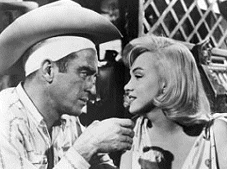 |
 |
Marilyn’s
marriage to Miller was obviously on the rocks and she was still mixed-up
over her affair with Yves Montand, believing he’d leave his wife Simone
Signoret for her. So the unit was split into two camps – those who were on Marilyn’s payroll and those who sympathised with Miller over the disgraceful treatment he was receiving from her. Marilyn’s camp included Paula Strasberg, her make-up man Whitey Snyder, her publicity man Rupert Allen, May Reis, her secretary, Ralph Roberts, her masseur, Anna Flanagan, her personal maid, another hairdresser and maid, a stand-in, body cosmetician, wardrobe girl and seamstress. The strain on Miller, the rejection and the humiliation she inflicted on him in public, must have taken their toll, yet he was still protective of her and heartbroken by her deteriorating state. Fortunately for him, he was to meet photographer Inge Morath, who was covering the film for a major photo agency and they fell in love and she became his third wife. Huston said of Marilyn, “She was in very bad shape. She was really in no condition to do the picture. She shouldn’t have been anywhere near the camera if truth be known. She had this terrible worry about sleeping. She had by then become reliant on pills. She needed them to put her to sleep and then to wake her up again.” On 26th August, Clark Gable had a scene with Marilyn in which the ageing cowboy tells his girl, “Honey, we all got to go sometime, reason or no reason. Dyin’s as natural as livin’; a man who’s afraid to die is too afraid to live, far as I’ve ever seen. So there’s nothing to do but forget it, that’s all. Seems to me.” |
| That
night Marilyn took an accidental overdose of sleeping pills. Her stomach
was pumped, she was wrapped in a wet sheet, carried to a plane and flown
to Westside Hospital in Los Angeles suffering from an emotional and physical
breakdown. Marilyn had been taking six or seven Nembutals every night while
on location. Production of the film was halted for two weeks and Marilyn
remained at the hospital for ten days while the doctors withdrew her from
Nembutal and put her on Dexamyl. She returned to the set on 7th September,
seemingly revitalised. Of her performance, Huston was to say, “She went right down into her personal experience for everything, reached down and pulled something out of herself that was unique and extraordinary. She had no techniques. It was all truth, it was only Marilyn. But it was Marilyn plus. She found things, found things about womankind in herself.” A further humiliation of Miller took place when a birthday party was held for Frank LaRue, Monty Clift’s make-up man. Paula Strasberg was placed in charge of arrangements and she didn’t invite Arthur Miller. John Huston decided not to turn up and a few days later, on 17th October, he held a birthday party for Miller and Clift at the Christmas Tree Inn. Miller was 45 and Marilyn was invited and turned up. During the celebrations, cameraman Russell Melly stood up and gave a speech: “Arthur writes scripts and John shoots ducks. First Arthur screwed up the script and now his wife is screwing it up. Why don’t you wish him a happy birthday, Marilyn? Arthur doesn’t know whether the horse should be up or down. Marilyn thinks we should keep the scene showing her half naked in bed. Monty is buying into the Del Monte grapefruit business – this is truly the biggest bunch of Misfits I ever saw.” When Gable saw a rough cut of ‘The Misfits’ he thought it was the best picture he had made in his life. He shook Frank Taylor’s hand and told him, “I now have two things to be proud of in my career – ‘Gone With The Wind’ and this.” Gable was thrilled with the picture, but Marilyn was not. What had originally been meant as a starring vehicle for her had really turned out to be a man’s film. In the last major scene where Marilyn as Roslyn is trying to talk the cowboys into releasing the horses, she screams: “You liars! All of you! Liars! Men! Big Men! You’re only living when you can watch something die! Kill everything, that’s all you want! Why don’t you just kill yourselves and be happy? I pity you.” Marilyn felt the audience would just look on her as a hysterical woman, that she should have been given articulate lines to reason with the cowboys rather than a short, shrieking speech. She was furious with Miller and said, “He could have written me anything, and he comes up with this. If that’s what he thinks of me, then I’m not for him and he’s not for me.” Huston, Miller and Taylor were unhappy with the rough cut and wanted to re-shoot several scenes, but Gable vetoed it. His attorney told them, “Clark Gable will not accept any more script changes.” |
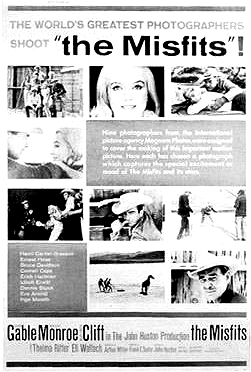 |
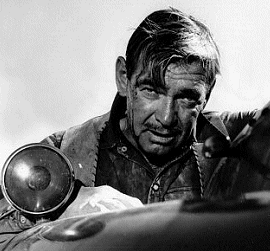 |
On 4th November, Clark said goodbye to the cast. The
next day at home on his ranch, he developed a pain in his chest. His wife
said, “Clark was ashen and sweating. We had an early dinner and he retired,
but in the middle of the night he woke up with a headache and what he described
as indigestion. In the morning, he tried to get dressed and almost collapsed.
I called the doctor despite Clark’s protesting over and over that he was
alright. The ambulance came. He was so embarrassed, but we made him get
in. Through it all he was concerned because I was pregnant.” Clark had suffered
a coronary thrombosis, but he seemed to recover and was in a cheerful mood,
asking for books and magazines to read. On 15th November Kay kissed him
goodnight and went into the adjoining room to lie down. The doctor said, “Around eleven, Clark turned the page of a magazine he was reading, put his head down, took a deep sigh, and died.” Reporters contacted Marilyn at 2am to tell her and she became hysterical. She felt guilty about his death. The film had gone 40 days over budget and cost an unprecedented $3,955,000. It was released in 1961 but was not a success and received a critical bashing, although Kate Cameron wrote in the New York Daily News: “Gable has never done anything better on the screen, nor has Miss Monroe. Gable’s acting is vibrant and lusty, hers true to the character as written by Miller.” The basic tale relates how Roslyn comes to Reno for the statutory three week residency period waiting for divorce (actor friend Kevin McCarthy played her husband). She meets a cowboy Gay Langland (Gable) and they set up a home outside town provided by Guido (Eli Wallach). The two men pick up another hand, Perce Howland (Clift) at a nearby rodeo and they plan a mustang roundup. Roslyn is horrified to discover that they intend to sell the mustangs for dog food and pleads with them to stop. Guido and Perce do, but Gay goes on to capture a wild steed. Once he’s subdued it, he turns it loose and sets off with Roslyn to look for another job. ‘The Misfits’ of the title refer to the wild horses, but many people think of the tragic cast, Gable, Marilyn and Clift, who were all to die not long after the film’s completion (Clift was to make two more films), as more suited to the title. |
|
Article
|